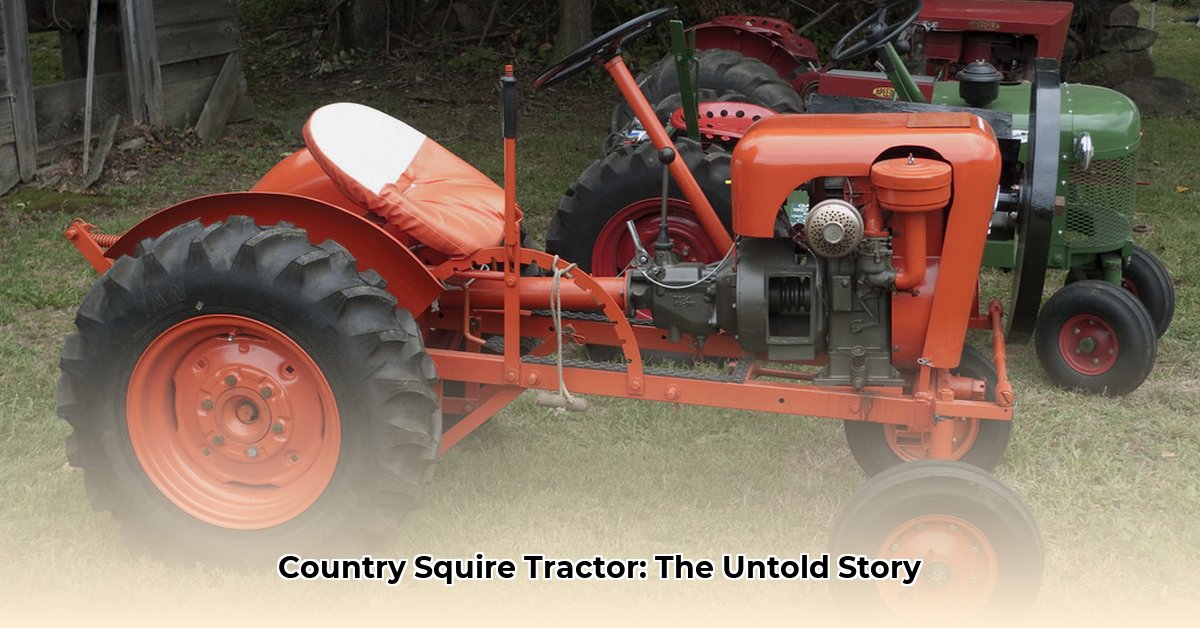
Country Squire Tractor: A Deep Dive into History and Mechanics
The Economy Country Squire tractor. The name evokes images of simpler times, a post-World War II era when farming shifted from backbreaking labor to mechanized efficiency. This wasn't a behemoth for vast fields; it was a tractor designed for everyday folks, a workhorse perfect for the average family farm or even a sizable backyard. Let's explore its journey, from its humble beginnings to current collector status. See more vintage tractor photos at this great site.
How did the compact size of the Country Squire affect its overall efficiency and maneuverability compared to larger tractors? Its smaller size was a significant advantage, enabling maneuverability in tighter spaces not easily accessible to larger equipment.
The Post-War Agricultural Revolution and the Country Squire's Arrival
Post-World War II America saw agriculture booming. Farmers, tired of manual labor, eagerly adopted new technologies. While large tractors existed, they were expensive and unnecessary for smaller operations. The Country Squire filled this gap, offering an affordable solution. It wasn't just efficiency; it was empowerment, giving individuals greater control over their land and improving their quality of life.
What specific technological advancements during this time directly influenced the design and features of the Country Squire tractor? The post-war focus on mass production and simplified design, coupled with advancements in smaller, more efficient engines, all played key roles in shaping the Country Squire.
The Country Squire: A Closer Look at the Machine
Imagine a compact, sturdy tractor: that's the Country Squire (1951-1962). Its core was a 9-horsepower engine—powerful for its time, though less so than today’s models. Coupled with a three-speed transmission, it handled diverse tasks. Lawn mowing? Tilling? The Country Squire, with its 30" or 48" mower decks, managed both. Its simple design was key to its success—easy to understand and maintain, vital before widespread repair shops.
What were some of the common maintenance procedures required for the Country Squire tractor, and how accessible were the necessary parts? The Country Squire's relatively simple design meant maintenance often involved basic tasks like oil changes, spark plug adjustments, and belt replacements. Parts availability varied regionally, but the overall simplicity made maintenance accessible even to novice users.
Marketing Genius: Reaching the People Directly
The Country Squire's success wasn't just about design. The marketing was revolutionary: direct-to-consumer sales through mail-order catalogs. This innovative approach bypassed dealerships, making the tractor widely accessible. Ordering it from home democratized tractor ownership, opening the door to those previously priced out.
How did the mail-order business model for the Country Squire tractor compare to the traditional dealership model and contribute to its success? The mail-order model reduced overhead and bypassed dealership markups, making the tractor significantly more affordable and attracting a broader range of customers.
Environmental Footprint: A Necessary Consideration
While revolutionary, the Country Squire wasn't environmentally ideal. Its gasoline engine contributed to emissions. Soil compaction, a concern with smaller tractors, needs further investigation. Existing data is limited, highlighting the need for more research to fully understand its long-term environmental impact compared to other farming practices of the era and modern alternatives.
What specific areas of environmental impact research regarding the Country Squire tractor are most crucial for a comprehensive understanding of its long-term sustainability? Key research areas include fuel efficiency metrics, detailed emissions analysis (comparing it with similar tractors of the period), and a quantitative assessment of soil compaction under various operational conditions.
Legacy and Collector's Interest: A Lasting Appeal
Decades later, the Country Squire remains a beloved piece of history. It's more than an antique; it symbolizes a simpler time. Its simple design makes restoration relatively easy, fueling its enduring appeal. It represents technology becoming accessible to everyone, not just large corporations.
What factors contribute to the continued collector's interest in the Country Squire tractor, and how does its historical significance enhance its value? Its relative simplicity, nostalgic appeal, and association with a bygone era of American agrarian life contribute significantly to collector interest, driving up its value among enthusiasts.
Technical Specifications: A Quick Overview
| Feature | Specification |
|---|---|
| Engine | Approximately 9hp (varied slightly by model) |
| Transmission | 3-speed |
| Drive Type | 2-Wheel Drive |
| Mower Deck Sizes | 30" and 48" options available |
| Production Years | 1951-1962 |
The Good and the Not-So-Good: Weighing the Country Squire's Pros and Cons
Strengths: Affordability, compact design, simple maintenance, direct sales.
Weaknesses: Limited power, basic transmission, environmental impact, potential for soil compaction.
The Country Squire's story isn't just technical; it's human. It's about ingenuity, accessibility, and humanity's evolving relationship with its tools. Its impact continues to fascinate.